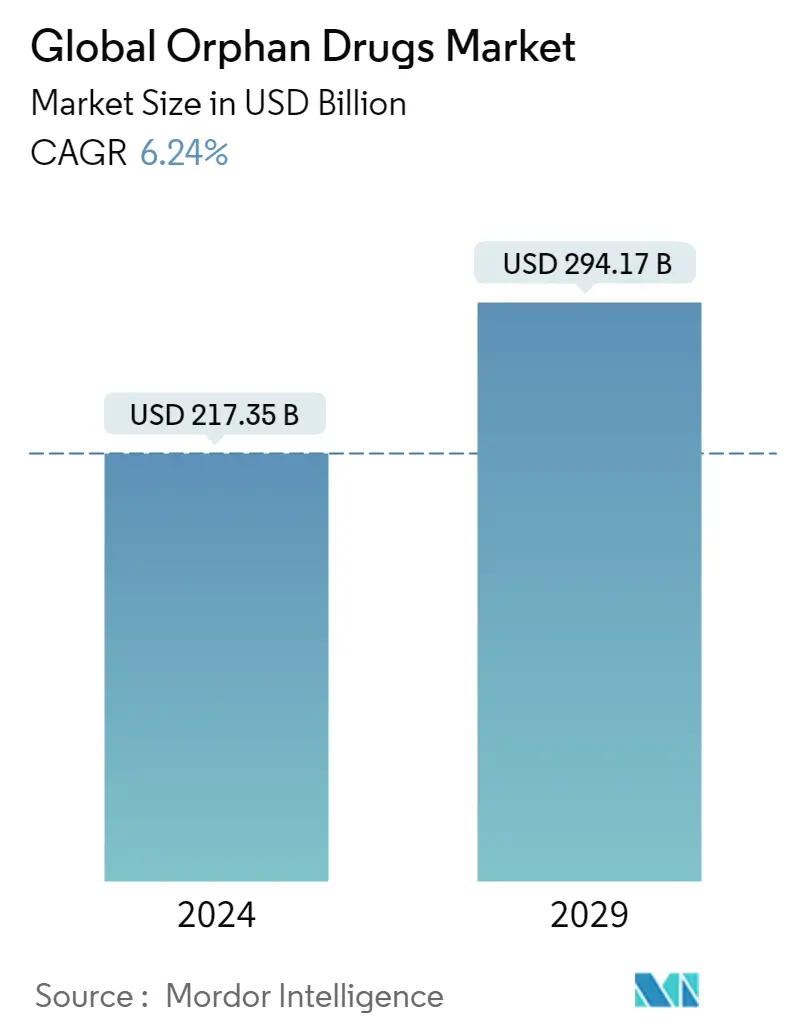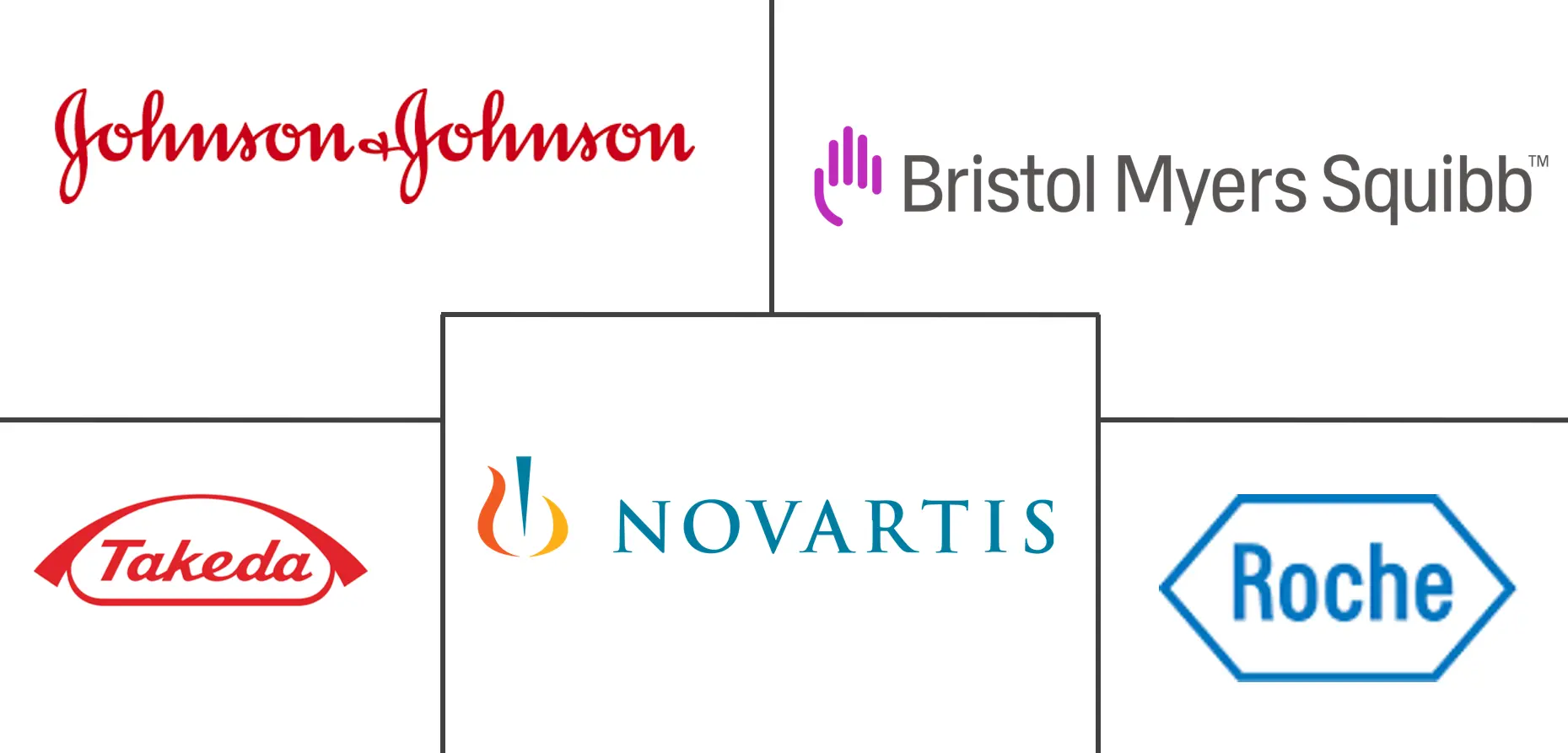Market Size of Global Orphan Drugs Industry

| Study Period | 2019 - 2029 |
| Market Size (2024) | USD 217.35 Billion |
| Market Size (2029) | USD 294.17 Billion |
| CAGR (2024 - 2029) | 6.24 % |
| Fastest Growing Market | Asia Pacific |
| Largest Market | North America |
| Market Concentration | Low |
Major Players
*Disclaimer: Major Players sorted in no particular order |
Orphan Drugs Market Analysis
The Global Orphan Drugs Market size is estimated at USD 217.35 billion in 2024, and is expected to reach USD 294.17 billion by 2029, growing at a CAGR of 6.24% during the forecast period (2024-2029).
The COVID-19 outbreak is an unprecedented public health concern that has had a significant impact on the orphan drug market globally as hospital and healthcare services were severely curtailed due to social exclusion and the supply chain was hampered. In September 2020, following criticism that treating covid-19 as a rare disease was "disingenuous," the United States Food and Drug Administration (FDA) has withdrawn orphan drug designation from a potential treatment for covid-19 from Gilead Science. Such instances may hamper the market growth during the pandemic. Thus, the pandemic is anticipated to have a significant impact on the studied market.
Some of the factors that are responsible for the growth of this market include market exclusivity for orphan drug developers, the rising prevalence of rare diseases, and favorable government policies.
Globally, the prevalence of rare diseases among the global population has been increasing in recent years. To tackle this issue, both developing and developed countries have formulated regulations that promote the development of drugs for rare diseases, as well as make sure that these drugs are easily availRare diseases: maintaining momentumable to patients. According to the Genetic and Rare Diseases (GARD) Information Center in May 2022, 1 in 10 Americans (or 30 million people) have a rare disease, and there are approximately 7,000 known rare diseases. Moreover, as per data updated in September 2021 by the "GlobalGenes", more than 400 million people worldwide are impacted by rare diseases. 80% of rare diseases have been identified with genetica origins. Moreover, as per the study titled "Rare diseases: maintaining momentum" published in March 2022, drug companies spent USD 22.9 billion in total in research on rare disorders in 2021, a 28% growth from 2020. Thus, growing prevalence and increasing research and development spending on rare diseases are creating opportunities for innovative orphan drugs. Thus, is expected to boost the market growth over the analysis period (2022-2027).
Additionally, favorable government policies for orphan drug approval and production support the market growth. Some of the countries with the well-recognized orphan drug act (ODA) include the United States, Japan, Australia, and Europe. Japan, with its health insurance for approximately 99% of its citizens, recently expanded its orphan drug criteria from less than 50,000 patients to less than 180,000 patients, to provide more opportunities for patients, payers, and providers, to achieve success against orphan diseases. In Europe, the European Medicines Agency (EMA) is the central organization related to facilitating the development and authorization of medicines for rare diseases. The approvals have been consistently high in the recent five years, across the European Union.
Furthermore, increasing research and development activities in the development of new therapies for rare diseases is also boosting the market growth. For instance, According to ClinicalTrails.gov in December 2021, a study titled "Oral Health-Related Quality of Life of Patients With Rare Diseases: a Qualitative Approach (RaroDentAXE3)" under the investigation from Assistance Publique - Hôpitaux de Paris is expected to be completed by December 2022. Thus, the rising number of studies on rare diseases is anticipated to boost the market growth over the forecast period.
Thus, all aforementioned factors are expected to boost the market growth over the forecast period. However, a limited patient pool for clinical trials and marketing restraint the market growth.
Orphan Drugs Industry Segmentation
As per the scope of the report, orphan drugs can be defined as a molecule intended to treat a rare disease. The rare disease, as the name suggests, has a low prevalence rate and has been defined differently across geographical locations. The Orphan Drugs Market is Segmented by Drug Type (Biological, Non-biological), Top Selling Drugs (Revlimid, Darzalex, Rituxan, Tafinlar, Ninlaro, Imbruvica, Myozyme, Soliris, Jakafi, Kyprolis, Other Top Selling Drugs), Disease Type (Oncology, Hematology, Neurology, Cardiovascular, Other Disease Types) and Geography (North America, Europe, Asia-Pacific, Middle East and Africa, and South America).The market report also covers the estimated market sizes and trends for 17 different countries across major regions globally. The report offers the value (in USD million) for the above segments.
| By Drug Type | |
| Biological | |
| Non-biological |
| By Top Selling Drugs | |
| Revlimid | |
| Darzalex | |
| Rituxan | |
| Tafinlar | |
| Ninlaro | |
| Imbruvica | |
| Myozyme | |
| Soliris | |
| Jakafi | |
| Kyprolis | |
| Other Top Selling Drugs |
| By Disease Type | |
| Oncology | |
| Hematology | |
| Neurology | |
| Cardiovascular | |
| Other Disease Types |
| Geography | ||||||||
| ||||||||
| ||||||||
| ||||||||
| ||||||||
|
Global Orphan Drugs Market Size Summary
The orphan drugs market is poised for significant growth, driven by factors such as market exclusivity for developers, increasing prevalence of rare diseases, and supportive government policies. The global landscape is characterized by a rising number of rare diseases, with both developed and developing nations implementing regulations to encourage the development and accessibility of orphan drugs. The COVID-19 pandemic has posed challenges, impacting supply chains and healthcare services, but the market is expected to recover and expand. The United States, Japan, Australia, and Europe are key regions with established orphan drug acts, facilitating drug development and approval processes. The growing investment in research and development for rare diseases further propels market growth, with neurological disorders representing a significant portion of the rare disease burden.
North America, particularly the United States, dominates the orphan drugs market, benefiting from favorable policies such as marketing exclusivity and financial incentives for drug developers. The high prevalence of rare diseases in the region has led to substantial government support through research grants and funding. The market is moderately competitive, with major players like Celgene Corporation, Takeda Pharmaceutical Company Limited, and Novartis AG leading the charge. The increasing number of drugs receiving orphan drug designation from regulatory bodies like the FDA is anticipated to further boost market growth. As the market continues to evolve, the combination of regulatory support, research advancements, and a growing patient base is expected to drive the orphan drugs market forward.
Global Orphan Drugs Market Size - Table of Contents
-
1. MARKET DYNAMICS
-
1.1 Market Overview
-
1.2 Market Drivers
-
1.2.1 Market Exclusivity for Orphan Drug Developers
-
1.2.2 Rising Prevalence of Rare Diseases
-
1.2.3 Favorable Government Policies
-
-
1.3 Market Restraints
-
1.3.1 High Per Patient Treatment Cost
-
1.3.2 Limited Patient Pool for Clinical Trials and Product Marketing
-
-
1.4 Porter's Five Force Analysis
-
1.4.1 Threat of New Entrants
-
1.4.2 Bargaining Power of Buyers/Consumers
-
1.4.3 Bargaining Power of Suppliers
-
1.4.4 Threat of Substitute Products
-
1.4.5 Intensity of Competitive Rivalry
-
-
-
2. MARKET SEGMENTATION (Market Size by Value - USD million)
-
2.1 By Drug Type
-
2.1.1 Biological
-
2.1.2 Non-biological
-
-
2.2 By Top Selling Drugs
-
2.2.1 Revlimid
-
2.2.2 Darzalex
-
2.2.3 Rituxan
-
2.2.4 Tafinlar
-
2.2.5 Ninlaro
-
2.2.6 Imbruvica
-
2.2.7 Myozyme
-
2.2.8 Soliris
-
2.2.9 Jakafi
-
2.2.10 Kyprolis
-
2.2.11 Other Top Selling Drugs
-
-
2.3 By Disease Type
-
2.3.1 Oncology
-
2.3.2 Hematology
-
2.3.3 Neurology
-
2.3.4 Cardiovascular
-
2.3.5 Other Disease Types
-
-
2.4 Geography
-
2.4.1 North America
-
2.4.1.1 United States
-
2.4.1.2 Canada
-
2.4.1.3 Mexico
-
-
2.4.2 Europe
-
2.4.2.1 Germany
-
2.4.2.2 United Kingdom
-
2.4.2.3 France
-
2.4.2.4 Italy
-
2.4.2.5 Spain
-
2.4.2.6 Rest of Europe
-
-
2.4.3 Asia-Pacific
-
2.4.3.1 China
-
2.4.3.2 Japan
-
2.4.3.3 India
-
2.4.3.4 Australia
-
2.4.3.5 South Korea
-
2.4.3.6 Rest of Asia-Pacific
-
-
2.4.4 Middle East and Africa
-
2.4.4.1 GCC
-
2.4.4.2 South Africa
-
2.4.4.3 Rest of Middle East and Africa
-
-
2.4.5 South America
-
2.4.5.1 Brazil
-
2.4.5.2 Argentina
-
2.4.5.3 Rest of South America
-
-
-
Global Orphan Drugs Market Size FAQs
How big is the Global Orphan Drugs Market?
The Global Orphan Drugs Market size is expected to reach USD 217.35 billion in 2024 and grow at a CAGR of 6.24% to reach USD 294.17 billion by 2029.
What is the current Global Orphan Drugs Market size?
In 2024, the Global Orphan Drugs Market size is expected to reach USD 217.35 billion.

